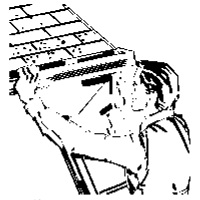|
Avoiding
Web Basements
Here’s a fact
that may surprise the homeowners – the
search for
a leaky basement begins on the roof.
When enthusiastic sellers crank up
the dehumidifier and paint over the flaking plaster, it’s easy
to overlook even long-standing basement problems. Still, there’s
no hiding lousy grading when viewed from above. Faulty gutters and
downspouts mean every raindrop that falls on the roof is going to
end up on the ground within a few inches of the foundation wall.
foundation wall.
Realtors are presented with a particular problem when selling a
home with a leaky basement. It’s easy to disguise the problem
long enough for a sale to take place, but impossible to prevent
from showing up. Inevitably, it will, and inevitably, the buyer
will feel tricked or betrayed. Those feelings usually lead to
lawsuits. Though a Realtor and a homeowner may want to leave the
roof climbing to a professional inspector, they’d be smart to
walk around the house and assure the grading is always away from
the walls. If the ground is flat or slopes towards the house,
there is a chance of a leaking basement.
Other clues will include stains on the gutters and downspouts,
which indicate they maybe blocked or overflowing. Another clue is
the connection where the downspout enters the storm drain because
a depression or washout in that area indicates water is backing up
or spilling.
Even inside the house, there are signs of persistent wetness. For
example, basement window sills should be free of rot and stain.
There should be no rusty nails in the molding in the basement. A
red flag should go up if the homeowner notices flaking of plaster
walls or powder on the surface of masonry walls. A musty smell
means trouble, as does buckled paneling, lifting tiles, or
imperfections in drywall.
Home inspectors use a moisture meter to detect dampness inside
walls, floors, and window sills. This moisture will show up even
if the room has been dehumidified. Moisture meters are available
to homeowners and are rather inexpensive. Considering the cost of
a lawsuit, a meter may be well worth the investment.
|
|
continued
from front page...
taken during its application are to
blame. In response to local building code requirements and
public demand, manufacturers have been offering a "water
managed" — or drainable — system to residential
contractors since 1997. Unfortunately, a visual inspection
alone cannot evaluate the amount of water penetration or
damage to the substrate. A non-evasive scanner can be used to
determine areas of excess moisture, although it is unreliable
in determining amount of moisture. The most reliable method of
testing is the invasive probe meter. To test a typical home,
20 to 50 probes are necessary. Each probe consists of two
1/8th inch holes about 1 inch apart. The holes must be sealed
with an approved sealant following testing. There are
some visual indicators of potential problems. These
include cracks in the EIFS dressing bands around
windows, an increased level of humidity in the home, and
cracking, peeling, or blistering of paint. Swelling,
cracking, and rotting of window or door frames, and
staining, mold, or algae in or on the home are also
visual clues to potential problems.
|
|